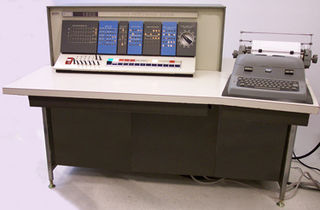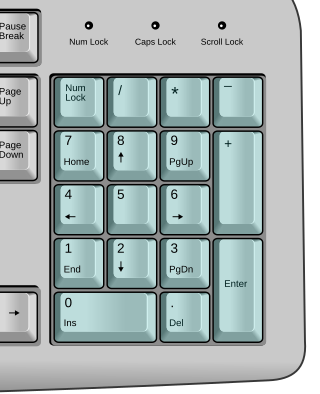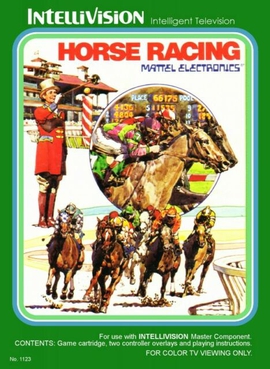Related Research Articles

The Atari 5200 SuperSystem or simply Atari 5200 is a home video game console introduced in 1982 by Atari, Inc. as a higher-end complement for the popular Atari Video Computer System. The VCS was renamed to Atari 2600 at the time of the 5200's launch. Created to compete with Mattel's Intellivision, the 5200 wound up a direct competitor of ColecoVision shortly after its release. While the Coleco system shipped with the first home version of Nintendo's Donkey Kong, the 5200 included the 1978 arcade game Super Breakout, which had already appeared on previous Atari home platforms.

The Microvision is the first handheld game console that used interchangeable cartridges and in that sense is reprogrammable. It was released by the Milton Bradley Company in November 1979 for a retail price of $49.99, equivalent to $212.00 in 2023.

Porky Pig is a cartoon character in the Warner Bros. Looney Tunes and Merrie Melodies series of cartoons. He was the first character created by the studio to draw audiences based on his star power, and the animators created many critically acclaimed shorts featuring the character. Even after he was supplanted by later characters, Porky continued to be popular with moviegoers and, more importantly, the Warners directors, who recast him in numerous everyman and sidekick roles.

The IBM 1620 was a model of scientific minicomputer produced by IBM. It was announced on October 21, 1959, and was then marketed as an inexpensive scientific computer. After a total production of about two thousand machines, it was withdrawn on November 19, 1970. Modified versions of the 1620 were used as the CPU of the IBM 1710 and IBM 1720 Industrial Process Control Systems.

A telephone keypad is a keypad installed on a push-button telephone or similar telecommunication device for dialing a telephone number. It was standardized when the dual-tone multi-frequency signaling (DTMF) system was developed in the Bell System in the United States in the 1960s – this replaced rotary dialing, that had been developed for electromechanical telephone switching systems. Because of the abundance of rotary dial equipment still on use well into the 1990s, many telephone keypads were also designed to be backwards-compatible: as well as producing DTMF pulses, they could optionally be switched to produce loop-disconnect pulses electronically.

A function key is a key on a computer or terminal keyboard that can be programmed to cause the operating system or an application program to perform certain actions, a form of soft key. On some keyboards/computers, function keys may have default actions, accessible on power-on.

Shooting Stars is a British television comedy panel game broadcast on BBC Two as a pilot in 1993, then as three full series from 1995 to 1997, then on BBC Choice from January to December 2002 with two series before returning to BBC Two for another three series from 2008 until its cancellation in 2011. Created and hosted by double-act Vic Reeves and Bob Mortimer, it uses the panel show format but with the comedians' often slapstick, surreal and anarchic humour that does not rely on rules in order to function, with the pair apparently ignoring existing rules or inventing new ones as and when the mood takes them.

The Speak & Spell line is a series of electronic hand-held child computers by Texas Instruments that consisted of a TMC0280 linear predictive coding speech synthesizer, a keyboard, and a receptor slot to receive one of a collection of ROM game library modules. The first Speak & Spell was introduced at the summer Consumer Electronics Show in June 1978, making it one of the earliest handheld electronic devices with a visual display to use interchangeable game cartridges. The company Basic Fun brought back the classic Speak & Spell in 2019 with some minor changes.

Safe-cracking is the process of opening a safe without either the combination or the key.
Shrek 4-D is an animated 4D film based on the Shrek franchise created by DreamWorks Animation, itself based on the book by William Steig. It also is a 4D simulator ride attraction with motion-based effects and water sprayers located at various theme parks around the world. It is currently shown at Universal Destinations & Experiences in Singapore, and previously in Universal Studios Florida, Hollywood, and Japan. The Hollywood location closed on August 14, 2017, to make way for the DreamWorks Theatre attraction, the Orlando location closed on January 10, 2022, to make way for Illumination's Villain-Con Minion Blast, and the Japan location closed on February 9, 2024. Outside the Universal parks, the movie was shown at Movie Park Germany in Germany from May 2008 until July 2011, and Warner Bros. Movie World in Australia from September 2005 until August 2010. A spin-off attraction titled Donkey's Photo Finish is located at the Florida venue while Meet Shrek and Donkey is located at the Hollywood venue. In Universal Studios Japan, the attraction is shown in the same theater as Sesame Street 4-D Movie Magic, with the Shrek 4-D film shown for the first 12 hours of the day, and the Sesame Street film shown for the next 12 hours of the day.

Japanese input methods are used to input Japanese characters on a computer.

T9 is a predictive text technology for mobile phones, originally developed by Tegic Communications, now part of Nuance Communications. T9 stands for Text on 9 keys.
On personal computers with numeric keypads that use Microsoft operating systems, such as Windows, many characters that do not have a dedicated key combination on the keyboard may nevertheless be entered using the Alt code. This is done by pressing and holding the Alt key, then typing a number on the keyboard's numeric keypad that identifies the character and then releasing Alt.
Various accessories for the PlayStation 3 video game console have been produced by Sony and third-party companies. These include controllers, audio and video input devices like microphones, video cameras, and cables for better sound and picture quality.

Video & Arcade Top 10 was a Canadian game show broadcast on YTV from 1991 to 2006. Filmed at Pyman Studios in Mississauga, Ontario, it was a competitive game show in which contestants played against each other in video games for prizes, with assorted review and profile segments on current games, music, and movies featured as well. V&A Top 10 is one of a select few English language Canadian game shows to run nationally for at least 15 years, joining Front Page Challenge, Reach For The Top, and Definition in that category. Reruns of the series from the late 1990s and 2000s aired on GameTV from November 2011 to September 2012.
Encounter in the Third Dimension is a 3-D film directed by Ben Stassen and Sean McLeod Phillips. It was released in the US on March 31, 1999. It has been shown in 3-D theaters and released on DVD with 3-D glasses, in both 2-D and 3-D format.

A numeric keypad, number pad, numpad, or ten key, is the palm-sized, usually-17-key section of a standard computer keyboard, usually on the far right. It provides calculator-style efficiency for entering numbers.
The Philippine peso sign (₱) is the currency symbol used for the Philippine peso, the official currency of the Philippines. The symbol resembles a Latin letter P with two horizontal strokes. It differs from the currency symbol used for the peso in Latin America, which is "$".

Horse Racing is an equestrian video game released by Mattel Electronics for its Intellivision video game console in 1980. Although primarily a sports video game, Horse Racing received Mattel's "Gaming Network" branding, due to its pari-mutuel betting on horses during the game.

Barbie: Mermaid Power or Barbie Mermaid Power is a 2022 animated musical adventure comedy children's television film directed by Emory Ronald "Ron" Myrick and written by Ann Austen.
References
- ↑ Hyatt, Wesley (1997). The Encyclopedia of Daytime Television . Watson-Guptill Publications. p. 279. ISBN 978-0823083152 . Retrieved 22 March 2020.
- ↑ Woolery, George W. (1985). Children's Television: The First Thirty-Five Years, 1946-1981, Part II: Live, Film, and Tape Series. The Scarecrow Press. pp. 326–328. ISBN 0-8108-1651-2.